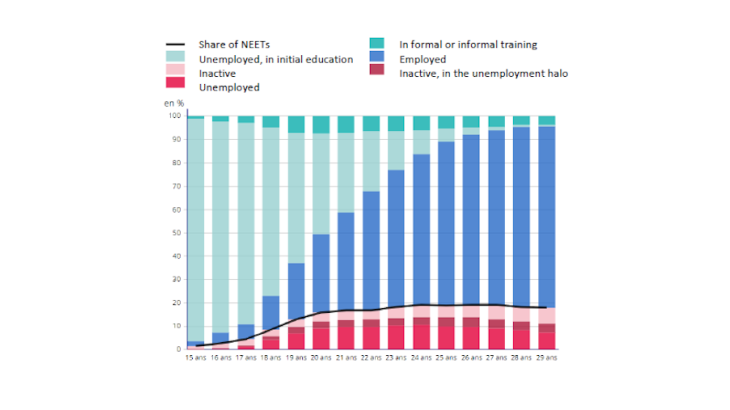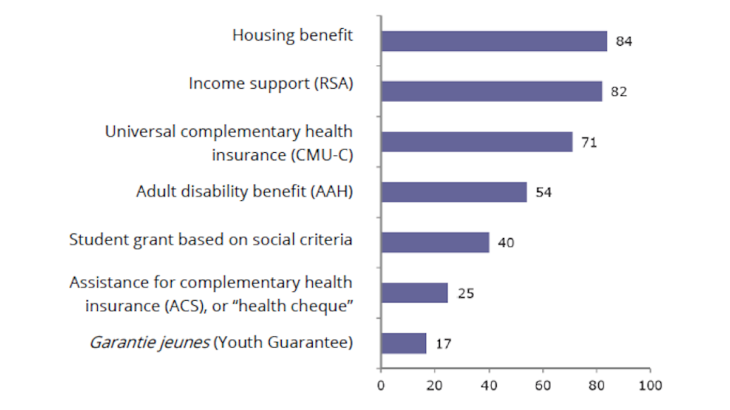- Home
- Publications et statistiques
- Publications
- The Covid-19 crisis and the risk of a sa...
Post n°242. 1st prize of 2021 Eco Notepad competition for students
While young people are the age group least affected by the virus, they are among the worst affected by the economic consequences of the crisis. Financial support schemes for young people need to be simplified to make them more accessible. They also need to be directed more towards measures that foster autonomy and professional integration.

Note: In annual average terms, between 2015 and 2019, 1.5% of 15 year-olds were not in employment, education or training (NEET).
A generation whose difficulties have been exacerbated by the crisis
A heterogeneous population burdened by structural problems
Young people’s educational attainment and socio-professional integration depend on social variables (social context), place of residence (vulnerable areas, French overseas regions, etc.) and personal factors. However, they also face common constraints and uncertainties that are specific to this segment of the population.
According to INSEE, more than half of people living in poverty in France (i.e. with less than 50% of the median income) are under the age of 30. One in five 15-24 year-olds are unemployed, while a disproportionate share of young workers are on short-term contracts (fixed-term or temping contracts, apprenticeships) or underemployed. In addition, in 2019, 12.9% of 15-29 year-olds, or close to 1.5 million young people, were not in employment, education or training (NEETs; see Chart 1). This share rose to 13.5% in 2020 with the onset of the public health crisis, although in the third quarter of 2021 it stood at 11.6%, which is still high but slightly lower than before the crisis, mainly thanks to the increase in youth employment.
The crisis is exacerbating the difficulties facing young people
The crisis is increasing these difficulties via two main channels: loss of income and obstacles to professional integration. First, “82% of students in paid employment have experienced financial hardship since the start of the public health crisis” (IPSOS, May 2021). Even more worryingly, 58% of students who previously carried out paid work either lost or had to reduce or change that work as a result of the lockdown, and this figure is likely to be an underestimate due to the often informal nature of this type of activity (e.g. babysitting). The average loss of income for these students is EUR 274 per month, while the average monthly student income is EUR 919 (OVE, 2021).
In an uncertain economic environment, young people have been the main victims of the labour market contraction. In a survey of close to 6,000 students, a large number of respondents said the crisis had disrupted their plans to take up an internship or a job abroad, while 57% said that the lockdown would affect their ability to continue their studies (OVE, 2020).
Internships, which are an important stepping stone towards employment, have become increasingly hard to find (decline of 22% in 2020 according to the DARES). Moreover, the quality of internship experiences has also been negatively affected, with remote working making it harder to acquire essential soft skills, for example. The fact that many internships have been postponed because of the crisis means that they are now clashing with the influx of young people into the job market, as internships are more attractive financially for employers. The crisis is thus making it harder for young people to enter the labour market, which could cause long-term scars if this unemployment proves persistent (loss of skills) or makes individuals less attractive to employers.
Higher youth unemployment has harmful consequences. Young people who have been unemployed are more likely to find themselves out of work in later years. They are also likely to earn less than those who find jobs more easily, with the penalty reaching as much as 20% and lasting for as long as 20 years (Morsy, 2012). During the 2008 financial crisis, the rise in unemployment led to greater income inequality in advanced economies, largely because it predominantly affected young people and the poorly qualified who were already facing difficulties. This inequality hampers economic growth: poorer people have a higher propensity to spend than the rich, so a concentration of wealth among better-off households can limit consumption and in turn weigh on investment.
Measures for young people must mitigate the difficulties linked to the economic environment, but also tackle the structural problems
A need to simplify the schemes in place
Simplifying the existing schemes for young people would make them more efficient. The existing public benefits contain over 120 age criteria, and include a variety of initiatives with different terms, governance systems and objectives. As a result, take-up rates for these schemes are low and they can create a sense of mistrust vis-à-vis the government.

The 1 jeune 1 solution (1 young person, 1 solution) initiative is a useful innovation and one of its programmes in particular (Aide à l’Embauche des Jeunes – a hiring subsidy for employers) has improved the quality and stability of young people’s jobs, even if it has not necessarily led to a rise in youth employment. To build on this, it is essential to distribute information on young people’s rights within schools, set up “rights meetings”, continue shifting application processes online (and provide help for the digitally illiterate), or merge as many as possible of the age limits for existing benefits. Finland has had some success with its “one stop shop” guidance centres for young people – temporary stands at universities and schools that provide information on all available benefits.
Young people need to be given the means to become independent and join the job market
Several solutions have been put forward to meet the need for youth training, make up for the lack of income support before the age of 25, and give young people greater autonomy and the means to succeed.
Even before the crisis, a third of young people said they were thinking of changing course because of the high cost of their studies, and this proportion is likely to rise as more and more young people experience financial hardship. As a result, public debate has once again focused on the idea of a “capital jeunes”. This would take the form of a EUR 10,000 loan guaranteed by the government, to be repaid over 30 years but only when the borrower’s income is above a certain threshold. It would transform the existing model for preventing youth poverty to one that no longer relies solely on benefit payments to young people or their parents, but rather fosters independence by giving young people a capital sum that they can use to achieve their aspirations. On the downside, however, it would still create inequality as those on low incomes would be burdened with debt repayments shortly after entering the labour market. In addition, if it is used to pay for studies, it is important to prevent it from pushing up student fees, as occurred in the United States or the United Kingdom with the widespread expansion of the student loan system.
Another solution would be to allow universal access to the Garantie jeunes (Youth Guarantee): this system could be extended to all young people looking for work or training, and the degree of support and terms of the scheme could be adapted over time in order to suit all profiles. The advantage of the Garantie jeunes is that it combines a EUR 500 monthly grant with personalised guidance on looking for work, and could be used to merge several existing initiatives targeted at young people.
Another avenue worth exploring is the example of Denmark: students receive a government grant in return for strict attendance of a recognised training course. The grant amount varies depending on the student’s place of residence, whether or not they have additional sources of income, and the date on which they start their studies. This example shows that public spending for young people is not so much a form of assistance as an investment.
Updated on the 25th of July 2024